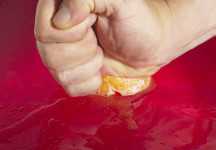Multiple Factors Continue To Squeeze Orange Crop

Since a 154 million box orange crop forecast was released by the Florida Agricultural and Statistics Service (FASS) in October, there have been multiple downward revisions with a forecast released earlier this month of 141 million boxes. Although I have verified this observation, I do not remember an instance in which the crop forecast has been reduced by this magnitude other than resulting from a freeze or hurricane. The reasons given by FASS for the reduction in orange crop (and grapefruit, too) is increased fruit drop and small fruit size.
Some level of fruit drop is normal during any crop year, but increased fruit drop can be caused by a variety of factors that induce tree stress including drought. Citrus canker is known to promote premature fruit drop. Fruit drop also is one of the most important symptoms associated with HLB. Since the high level of fruit drop this season seems be in the early-mid crop and Hamlins are more susceptible to canker than Valenicas, my suspicion is that the heavy level of fruit drop is a combination of canker, HLB, and the mild winter that Florida has experienced (through mid-January).
Price Probe
What does this mean for processed orange prices? With the crop now expected to be markedly smaller than the 2011-2012 crop, prices should remain at a level comparable to last season even though juice inventories have increased. Retailers and brands have not decreased retail prices.
The price outlook for Florida remains positive despite the train wreck that describes the 2012-2013 season in São Paulo, Brazil. As a consequence of the large crop in São Paulo in the 2011-2012 season, the government of Brazil chose to initiate a program called Consecitrus (“for citrus”), which provided low-cost financing for juice storage and imposed a price floor for oranges delivered to processors. As a consequence, Brazilian processors entered the 2012-2013 season with more than 600,000 metric tons of FCOJ in inventory, which is equivalent to nearly 850 million single strength equivalent gallons of orange juice. This is about the same amount of orange juice that Florida is expected to produce in 2012-2013.
Taking Stock
With such a large inventory, Brazil processors chose not to purchase any early maturing varieties and processed only that fruit committed through long-term contracts (including fruit owned by the processors themselves). CEPEA, a market news organization based at the University of São Paulo, reports that an estimated 40 million boxes of fruit were abandoned. The price paid for harvested fruit on the cash market ranged from the equivalent of $3.00 to $3.50 per box, on-tree.
Another factor that will be positive for fresh fruit growers is the recent freeze in Central California. Although California is a small supplier of orange juice, it remains the main supplier of fresh oranges and tangerines to the U.S. market. With the magnitude of the California freeze, 2012-2013 will be much like 2006-2007, which was the last major freeze in California.
With declining tree numbers and the effects of canker and HLB, the Florida orange crop is not likely to exceed 150 million boxes, at least in the
next five years. This means that while prices should remain favorable, until a solution to HLB
is found, I do not expect a major recovery of orange production in Florida.









